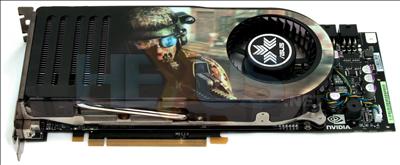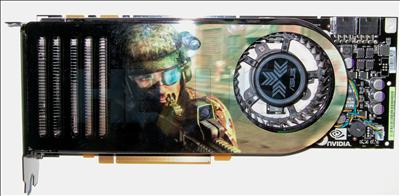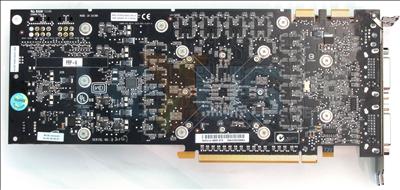Retail G80 in the house!
ASUS' GeForce 8800 GTX SKU is based strictly on the reference design. The only difference is ASUS branding on the heatsink and fan. That entails a base core clock of 575MHz, shaders running at 1.35GHz, and 768MiB of GDDR3 card memory operating at an effective 1800MHz. The 384-bit memory interface offers 86.4GB/s of bandwidth and the chip itself, comprised of around 681M transistors and measuring in at 20x22mm, is, well, huge. The process by which G80 harnesses its unified shading power is quite different from either GeForce 7900 GTX or ATI's Radeon X1950 XTX. Its scalar ALU architecture offers up some staggering shading numbers and Shader Model 4.0 keeps it spiffing new. If you want to know the how and why GeForce 8800 GTX is a real next-generation part from both architecture and, inextricably, potential performance, head on over to our technical take.
Back to the ASUS implementation. The card measures in at a whopping 267mm and tips the scales at 740g, thanks to its copious cooling based on a double-width design. You will need to ensure that your chassis can accommodate one, should G80 tickle your gaming sensibilities.
The first photograph highlights NVIDIA's trusted heatpipe-based approach to cooling. The absorbed heat is wicked away to the back of the enclosed cooler, to the fins, and then forced directly out of the back by the off-centre blower. The cooler is virtually inaudible in 2D and very quiet in full-blown 3D, with the fan barely spinning any faster. That's huge bonus for all thinking of G80 but worried about its aural characteristics. In fact, we'd go as far to say it's quieter than ATI revised Radeon X1950 XTX cooling, so two thumbs up for NVIDIA on the heatsink-engineering approach.
Our labs. manager, James Smith, has had his sticky fingers all over the card. Rumour has it he even slept with it but this needs to be substantiated. Whatever the case, if the fingerprints match up to a crime scene involving gnomes you will know who to contact.
Above, you can see the double-height rear section. By their very nature, high-end cards require heatsinks with greater dissipation area. We'll have to wait until NVIDIA launches a 'castrated' SKU before a single-slot G80-derived card becomes available.
On to more serious matters. Both DVI ports offer dual-link bandwidth, which is enough to drive QWXGA displays with ease.
The gargantuan cooler takes up most of the PCB. What's interesting to note is the usage of dual 6-pin PCIe power connectors. Running at full bore the card can peak at >150W, so you'll need a high-quality PSU with plenty of 12V oomph to run one in a system featuring other high-end components, presumably.
The rear aspect highlights the two SLI connectors that are present on the GTX SKU. Don't worry; you will only have to use one for some high-octane SLI fun. The unused connector is reserved for future three-card+ setups.














